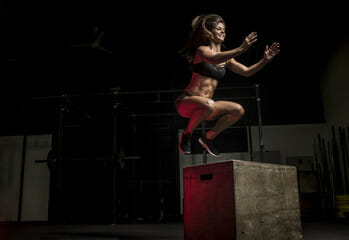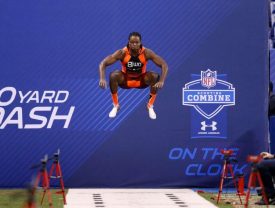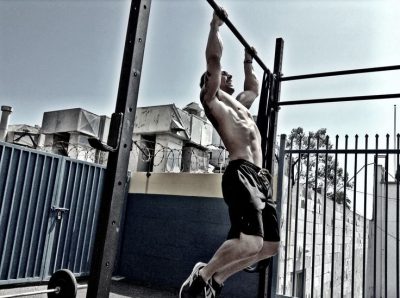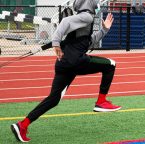I remember the first time I heard about plyometric exercises.
Like a lot of fitness enthusiasts my age, Tony Horton and the P90X plyometrics workout was my introduction to the world of high-impact, high-intensity training.
P90X was released in 2005, and A LOT has changed since then.
Most notably, plyometrics is the norm in most high-intensity workouts. For example, CrossFit is a big fan of plyometrics, especially the Plyo Box Jump and Battle Rope Slams.
Commercial fitness aside, what about plyometrics for athletes?
Do plyometric workouts have a place in the training of a football player, swimmer, or boxer?
Let’s take a closer look at plyometric exercises, the benefits of plyometrics for athletes, and the best workouts to start using today.
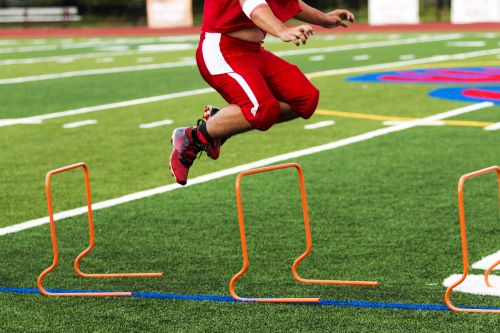
What are Plyometrics?
Also called jump training, plyometric exercise involves eccentric-focused movements where the goal is to generate maximum force in the shortest amount of time.
Another way to look at plyometric exercise is the deliberate pre-stretching of a muscle followed by the immediate contraction of the same muscle group.
The best example of this is when a person slightly squats before jumping into the air.
The eccentric-focused movement pattern of plyometric exercises is best demonstrated in the three phases of the stretch-shortening cycle: eccentric, amortization, and concentric.
Let’s take a deeper look at each phase…
Eccentric
This is the first phase of the stretch-shortening cycle that takes place in plyometric exercises.
During this phase, the muscle is pre-stretched, which allows it to build elastic energy that can be used for the coming movement.
Let’s look at the classic Plyo Box Jump as an example.
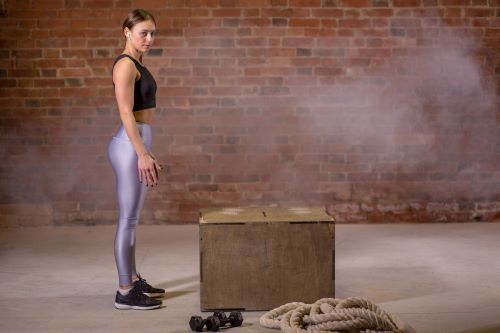
The first step in the Plyo Box Jump is the slight bending of the knees and hip hinge as the arms come up to chest height.
It’s this movement that prepares the body for the exercise by building up elastic or springy energy.
Related: Best Plyometric Boxes for Home Gyms
Amortization
The amortization phase is the delay between the first and third phase. The muscle has finished pre-stretching and it is about to use the buildup of elastic energy to move into the accelerated muscle contraction.

It should be noted that you can’t stay in this position for too long as you’ll have an energy leak and lose out on the elastic energy that you’ve built up.
Concentric
Now, it’s showtime. This is when the stored energy is utilized to generate a maximum force in the direction you want to go.
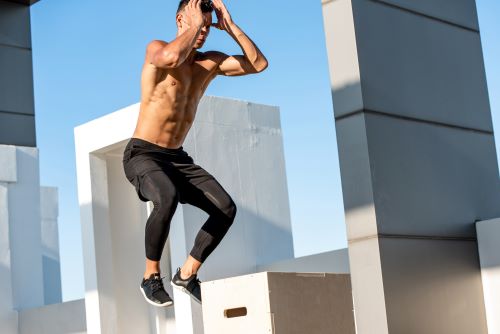
In the case of the Plyo Box Jump, the athlete would jump straight up and onto the box, landing in a squat position.
Related: The 3 Best Jumping Exercises for Athletes
Why Athletes Should Use Plyometrics
The funny thing is that if you’re an athlete, depending on your sport, you’ve probably been doing some form of plyo for a while.
For example, Plyo Box Jumps are a common exercise for basketball players to improve their vertical jump.
Plyometric workouts offer a variety of benefits for athletes and their respective sports. Here are some proven benefits of plyometric training along with some sports-specific examples.
1. Increased Jump Height and Distance
Studies show that lower-body plyometric exercises can significantly improve both the height and distance of your jump.
One study found that subjects saw the greatest improvement in their vertical jump when plyometric drills were used for no less than 10 weeks. [1]
In other words, the longer you incorporate plyometric exercise drills, the more you’ll improve.
This makes lower-body plyometric workouts invaluable for basketball players, volleyball players, etc.
Related: Vert Shock Verticle Jump Training Program
2. Increased Strength
When plyometric exercises are incorporated into a resistance training program, strength levels skyrocket.
One meta-analysis of 15 studies concluded that plyometric exercises help to increase strength levels in all subjects, regardless of fitness experience.
What’s more, researchers point out that optimal results come from using a variety of training methods, not just one. This means that plyometric exercises are an ideal complement to many fitness programs. [2]
This boost in strength will be helpful across the board for athletes, regardless of the sport.
3. Improved Speed, Agility, and Quickness (SAQ)
Athletes aren’t strangers to speed, agility, and quickness (SAQ) drills. From cone drills to ladder drills, athletes in almost every sport have run through a series of these exercises.
It should come as no surprise that plyometric exercises improve your performance during SAQ drills. In fact, when you get to see the plyometric workouts below, you might feel that they are oddly familiar to some of your sports training.
Studies show that plyo workouts activate the fast-twitch muscle fibers required for faster muscular contractions. One study found that plyometric drills helped to dramatically increase sprinting speed. [3]
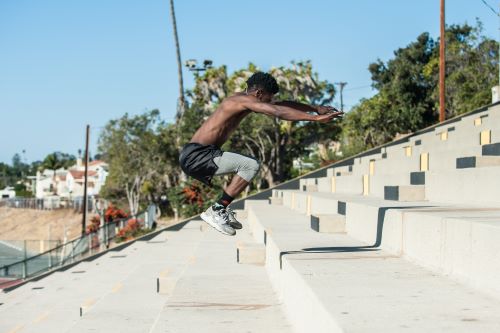
4. Increased Power
Power is the combination of strength with speed. Plyometric exercises have been shown to increase both speed and strength, so it follows that these exercises also improve power.
Power is as useful in football as it is in boxing. From defensive actions on the field to punching power in the ring, athletes require raw power and plyometric training can help you build more of it.
One study, in particular, found that plyometrics were especially helpful for improving countermovement jumps and depth jumps. [4]
But what about the upper body strength and power?
Another study focused on what would happen if female handball players performed plyometric drills for 10 weeks.
The result?
Researchers found that the athletes showed significant improvements in handgrip force, back extensor strength. and medicine ball throwing. They also noted that reaction times had shortened, implying speed was also positively impacted. [5]
Related: How to Build Powerful Athletes: Power Building Workouts
5. Increased Bone Density
Bone density is one of the biggest concerns for an aging population. Studies show that over time, bone density naturally decreases.
However, one of the best ways to slow down and potentially reverse bone density loss is with plyometric exercises.
Plyo movements are high impact, which have been shown to promote bone mass growth. [6]
Best Plyometrics Exercises for Athletes
Ready to start adding some plyometric exercises into your weekly training program? Here are the best plyometrics exercises for both the lower and upper body.
Best Lower Body Plyometric Exercises
Box Jumps
The standard box jump begins with a normal vertical jump, stepping off of the ground and then jumping up onto a target (e.g., an elevated platform). The benefit of using such raised platforms is that they can be adjusted to accommodate different levels of training, while also allowing the exerciser to use weights if desired.
Box jumps should be performed in a controlled method by landing on top of the box with both feet, maintaining balance and control throughout the movement. The height and number of repetitions depend on the athlete’s level of fitness and goals—higher reps for power endurance or lower reps for maximum strength or explosiveness. This plyometric exercise also requires that you have enough strength to absorb impact from repeated jumps to avoid potential injury.
Lateral Jumps
Lateral jumps involve moving from side to side, or changing directions as quickly as possible. The exercises for this plyometric exercise include Side to Side Hops and Tuck Jumps. In the first, you alternate jumping straight up with each foot landing outside of your body’s midline (i.e., not directly beside your other foot) during each rep. Tuck Jumps are similar but require that you jump explosively while bringing your knees toward your chest at the highest point of the jump (similar to a vertical jump). Your goal is to push off hard enough so that after executing these two jumps back-to-back, you’ve moved laterally far enough to cut across an imaginary line 10 feet away from where you began.
Plyo Lunges
These plyometric exercises are similar to traditional lunges, except that you alternate between bringing your front foot forward and pushing off with it while simultaneously bringing your back foot up toward the planted front foot. The key to this exercise is to push hard off of the floor with each leg as you switch, keeping the motion continuous. Each step should be executed quickly, so that you are lunging down and bringing your back foot forward in a quick, fluid motion. After lunging down and up with your back leg, you’ll immediately lunge again only this time with the front foot that is now back.
Depth Jumps
This is a plyometric exercise that involves jumping up as high as you can after dropping from a stationary position, with the goal of achieving maximum height with each jump.
Begin by standing on a sturdy, elevated surface (e.g., box, step) with your feet shoulder-width apart and keeping your back straight. After you’ve gathered yourself and feel ready, step off (or hop off) the platform, landing with both feet simultaneously on the ground below. As soon as your feet hit the floor, immediately jump up again with both feet to maximize height before your body returns to the floor.
Band Resisted Broad Jump
This exercise requires a resistance band or another elastic-type band that you’ll attach to your body (e.g., around your waist) on one end and to a sturdy object on the other end. The resistance band should be taut at all times, so adjust it accordingly before you perform this plyometric exercise. After you are properly attached, take a few steps back. Then, using the entire length of your legs, jump forward as far as you can. Remember to land silently on the ground and immediately explode upward as high as possible, jumping forward with both feet at once.
Band Resisted Lateral Jump
This exercise involves using the resistance band for added resistance by jumping laterally. The level of difficulty can be increased greatly by attaching the band around your waist and stepping sideways, jumping as far as you can to your right or left. Keep moving in that direction with each subsequent jump until you have traveled far enough to complete one full lap around an athletic field.
For an added challenge, you can jump explosively off of one foot to your right or left while using the band for resistance. This adds plyometric elements because you are training yourself to land on a single leg with enough stability and control so that you do not need to use two feet. Make sure your hips stay square during this exercise, with your torso leaning slightly forward.
Best Upper Body Plyometric Exercises
Plyo Push-Ups
These plyometric exercises involve performing explosive push-ups using an elastic band for added resistance. Like many of the other plyometric exercises, this one will work your entire body, but it requires the most upper-body power. Begin with your hands outside of your chest and feet together on the ground. Keep your hands slightly in front of your chest and directly under your shoulders.
Start with a lower push-up, then explosively push your hands off the ground, followed by your feet. Then, push yourself backward away from the band. Keep on pushing hard until you are at the furthest point from the band, and then push yourself forward again toward the band. Your feet should be together during your entire explosive movement.
Overhead Med Ball Throw
This plyometric exercise involves standing with the med ball overhead as you would stand for a standing long jump. From this position, lower the medball then throw it up in the air as high as possible. Catch the ball but do not let it drop below shoulder level, and immediately push up to begin the next rep.
Med Ball Slams
To do the med ball slams, hold a med ball with both hands up above your head, with arms extended and feet shoulder-width apart. From this position, thrust the med ball downward to the ground with all your might. As you slam it down, quickly grab the ball and throw it back up to the starting position.
Lateral Med Ball Wall Throw
To do this exercise, stand with the med ball near a wall. Bring your feet together and keep your arms slightly in front of you. Bring the ball behind you until it rests against your hamstrings. Thrust yourself forward off one foot and at the same time, throw the med ball directly into the wall. Catch it and repeat.
Med Ball Chest Pass
This exercise is basically the same thing as a two-handed basketball chest pass but with a med ball. Keep your feet shoulder-width apart and hold the med ball with both hands in front of you. Keep your arms slightly bent as you push the ball forward into a partner’s waiting chest. As soon as he catches it, repeat. You can also do this off of a wall if you don’t have a partner.
Wall Ball Squats
If you have ever done CrossfFit before you probably know this exercise. Stand with your feet should width apart and the med ball at your chest. Keep your chest up and shoulders back. Stand about 4 feet from the wall. Squat down until your thighs are about parallel to the floor, then drive upwards and push the med ball up by extending your arms. Aim to throw the ball about 10 feet high off the wall. Catch the ball and repeat.
Plyometrics Workouts for Athletes
You can use these workouts to complement your current program, in place of your current cardio workout, or as a standalone.
I’ll provide you with different acute variables based on your experience level.
Beginner Plyometric Workout
A beginner-level workout will focus on technique and execution, especially during the landing portion of the exercise.
You’ll want to hold the landing position for a couple of seconds before returning to the starting or eccentric position.
In other words, once you land or reach the end of the concentric position, hold yourself there for two seconds before the next repetition.
- Plyo Box Jump: 2 to 3 sets of 6 to 10 repetitions
- Depth Jump: 2-3 x 4-8
- Plyo Push-Up: 2-3 x 6-10
- Overhead Throw: 2-3 x 6-10
Intermediate Plyometric Workout
As you move into the next level of plyometric workouts, the focus begins to shift toward incorporating new planes of motion, mainly rotational movements.
Again, form and execution are just as important, but now rotational movements add a new degree of difficulty.
- Lateral Jumps: 2 to 3 sets of 6 to 10 repetitions
- Plyo Lunges: 2-3 x 4-10
- Lateral Wall Ball Throw: 2-3 x 4-10
- Medicine Ball Chest Pass: 2-3 x 6-12
Advanced Plyometric Workout
When you are ready to tackle advanced-level plyometric workouts, you can expect to incorporate all planes of motion at high speed and high intensity.
Never forget your foundational workouts as the basics will be essential at this stage of the game. Go hard but stay smart.
- Band Resisted Broad Jump: 2 to 3 sets of 6 to 12 repetitions
- Band Resisted Lateral Jump: 2-3 x 6-12
- Lateral Wall Ball Squats: 2-3 x 6-12
- Overhead Slam: 2-3 x 6-12
Staying Safe and Injury-Free with Plyometrics
Despite the benefits of plyometrics, it’s essential to take the necessary precautions.
Don’t forget that plyometric training is a high-impact form of exercise; it’s also high intensity. While plyometric exercises can improve the health of the ankle and knees, if you are not yet recovered from an injury or surgery, they can make your issue much worse.
That means if you have prior issues with any of your joints, especially your ankles, knees, and feet, you should have a chat with your physical therapist, doctor, and coach before beginning any type of plyometrics-focused workout.
References
- Stojanović, E., Ristić, V., McMaster, D.T. et al.Effect of Plyometric Training on Vertical Jump Performance in Female Athletes: A Systematic Review and Meta-Analysis. Sports Med 47, 975–986 (2017). https://doi.org/10.1007/s40279-016-0634-6.
- Sáez de Villarreal, Eduardo & Requena, Bernardo & Newton, Robert. (2009). Does plyometric training improve strength performance? A meta-analysis. Journal of science and medicine in sport / Sports Medicine Australia. 13. 513-22. 10.1016/j.jsams.2009.08.005.
- Sáez de Villarreal, Eduardo; Requena, Bernardo; Cronin, John B The Effects of Plyometric Training on Sprint Performance: A Meta-Analysis, Journal of Strength and Conditioning Research: February 2012 – Volume 26 – Issue 2 – p 575-584 doi: 10.1519/JSC.0b013e318220fd03.
- Makaruk, Hubert & Sacewicz, Tomasz. (2010). Effects of Plyometric Training on Maximal Power Output and Jumping Ability. Human Movement. 11. 17-22. 10.2478/v10038-010-0007-1.
- Hammami M, Gaamouri N, Suzuki K, Shephard RJ, Chelly MS. Effects of Upper and Lower Limb Plyometric Training Program on Components of Physical Performance in Young Female Handball Players. Front Physiol. 2020;11:1028. Published 2020 Aug 18. doi:10.3389/fphys.2020.01028.
- Witzke, Kara & Snow, Christine. (2000). Effects of plyometric jump training on bone mass in adolescent girl. Medicine and science in sports and exercise. 32. 1051-1057. 10.1097/00005768-200006000-00003.

David J. Sautter has combined a lifelong passion for writing with over a decade of experience as an NASM-certified personal trainer, fitness-nutrition specialist, and sports-conditioning specialist. David has written hundreds of blog posts as well as dozens of e-books, training guides, and online courses covering a range of health and fitness topics. In his free time, David enjoys writing about staying fit while traveling abroad for his blog, FitnessWanders.com. Learn more about David Sautter at WriteFit.com.

